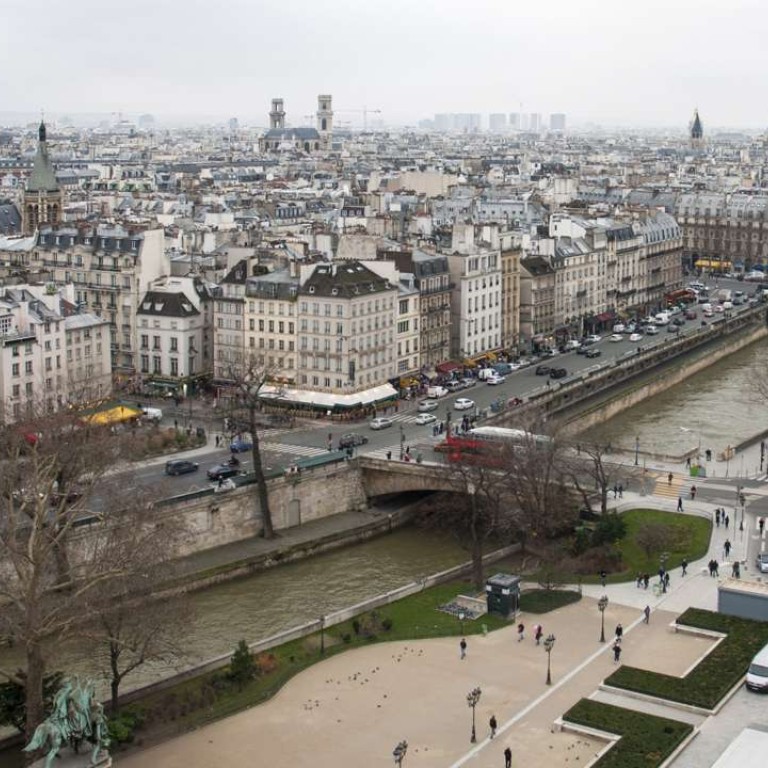
Parisians bring anti-skyscraper message to Hong Kong in Le French May show about beauty of city’s rooftops
As tall office towers begin to sprout around Paris, group lobbying for Unesco heritage status for skyline of French capital’s historic centre mount exhibition highlighting the romance of city’s rooftops
Le French May is bringing an exhibition to Hong Kong at the end of May that sounds like the usual evocation of romantic Paris. In fact, the show, called “Paris, Toits Emois” (The Roofs of Paris), wades into the touchy subject of whether the City of Light should be protected from the invasion of more high-rise developments.
Paris developed architectural acrophobia in 1973 with the completion of the 56-storey Montparnasse Tower. Parisians were so appalled by the incongruous, brown obelisk sticking out above the mass of low-rise, zinc-roofed buildings surrounding it that no skyscraper was allowed to be built near the city centre for the next 40 years. (They were still allowed in La Défense, the shiny, purpose-built business district safely tucked away to the west of central Paris.)

Just four visual landmarks used to stand out from the unobstructed viewpoint at the top of the Centre Pompidou: the 210-metre Montparnasse Tower, still an uncompromising silhouette on the left, the Eiffel Tower, Notre-Dame de Paris and the Basilica du Sacré-Coeur in Montmartre.
But now there’s a fifth. The soon-to-be-completed Paris Courthouse, the largest law court complex in Europe, designed by Renzo Piano, is a playful, 160-metre high stack of cubes that was approved in 2010 because the city relaxed a seven-storey height restriction. Office towers can now be as high as 180 metres.
Others are on their way, such as the controversial Triangle project. This is a 180-metre pyramidal business tower that the city’s Socialist mayor, Anna Hidalgo, pushed through in 2015 after she dismissed an earlier “no” vote by the city council as invalid.
So far, all the new buildings are at a safe distance from central Paris, but preservationists fear that their arrival marks a shift in policy that will jeopardise the integrity of the historic skyline in the future.
And that brings us to the Hong Kong exhibition.

“Paris, Toits Emois” is part of the lobbying effort for Unesco intangible heritage status to be given to the historic skyline of Paris, which supporters say may help slow efforts to change the city.
“A Unesco classification will shine the spotlight on the specificity, beauty and uniqueness of the colour of this capital city,” says Olivier Boileau Descamps, secretary general of the application committee and organiser of the Hong Kong exhibition.
It is not so much a conservation order but a recognition of the know-how of Parisian zinc roofers and the relevance today, he adds.
For example, energy conservation experts are rediscovering the virtues of the older buildings, such as natural ventilation features. “The future sometimes lies in rediscovering the qualities of ancestral techniques by adapting them to our modern life,” he says.
The exhibition will open on May 25 at the City University of Hong Kong, before travelling to other parts of the world. It will feature models, original casts and artwork from the Cité de l’Architecture et du Patrimoine and the Musée de Montmartre that are enhanced by multimedia projects by university students.

“Other European cities have their authentic historical buildings but not as many as in Paris. London suffered a lot of bombing during the second world war, for example,” says Emmanuel Breon, director of Cité de l’Architecture et du Patrimoine in Paris and curator of the Hong Kong exhibition.

In fact, the recent explosion in the number of high rises in London, and St Paul’s Cathedral now being in the shadows of the Shard, the Walkie Talkie, the Cheese Grater and the Gherkin, is exactly what many in Paris do not want to see.
However, Hidalgo’s government has stressed that allowing selective developments is essential for Paris to remain a competitive economy.
“Will we be the only country to reject a private investment of 500 million euros?” she said when the city council initially voted against The Triangle, while hailing other economic benefits such as job creation and signalling Paris’ openness to business. It is a mentality that Hongkongers are used to , but which is less popular in a city proud of its architectural heritage.
“We do not do politics, but what can be criticised is how our decision-makers are imagining Paris only with isolated towers. It is in my opinion totally dangerous as a vision of aesthetics,” says Descamps.
“When I was asked to head the exhibition to help the Unesco application, which was launched in 2015, I happily accepted. That is because it is a big fight to keep the roofs in Paris when people want to build towers,” Breon says.
He says he doesn’t want Paris to become stultified, and cites Piano’s Paris Courthouse as a positive addition to the skyline. “The Paris Courthouse is a nice addition and doesn’t interrupt the view of Montmartre. We are not saying Paris has to stand completely still, only that any development has to be sensitive to its skyline,” he adds.
Paris, Toits Emois – an unforgettable visual journey through views of Paris from high above. May 25-July 25, Mon to Sat, 12–7pm. City University Exhibition gallery, 18/F Lau Ming Wai Academic Building, Tat Chee Avenue, City University of Hong Kong
Editor’s note: this story was changed on April 7 to amend the name and address of the venue for the exhibition

